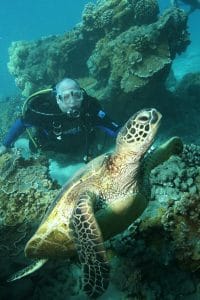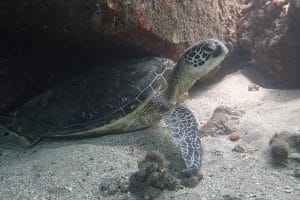Have you every seen a wild animal in need of help?
If you have, odds are it left a lasting impression on you. I know that Iʻll never forget the day I helped a green sea turtle.
All too often, when hearing of marine animals in crisis, it is the result of some sort of human impact; but my story is different. This was early in my career as a dive guide and SCUBA instructor on Maui. We were diving Olowalu Reef from the boat one afternoon, and Iʻd navigated my group through the sand channels and over the top of the reef to that mythical spot: the turtle cleaning station.
The Hawaiian Archipelego was the first place where turtle cleaning stations were scientifically documented as early as 1972. Turtles are known to repetitively come back to an area and adopt a ‘solicitation posture for cleaning’ where a few select species of fish respond by eating algae or even parasites off their hard shells, soft flippers and wrinkly necks.
A trip to Olowalu, Maui

Photo by Instructor Victoria
At this Olowalu cleaning station, the the area is utilized so frequently that the corals are beat down and worn down to what look like stubby, ashy rocks where the turtles repeatedly congregate. And it is there where my group and I witnessed one of those magical underwater moments. Some turtles were going up for a breath of air, others descending down to their favorite spot on the reef, others hovering like spacecraft motionless in the water column for cleaning by surgeonfish. There were still others perched on top of the worn corals, posturing by stretching out their neck and flippers for a good cleaning. At least six turtles in all occupied the space as my group slowly approached.
My group was awe struck by the scene they were witnessing…
As they took it in, I considered where best to get a photograph. A turtle in motion, remains in motion has always been my theory when trying to photograph these wonderful animals; so, I began to line up a photo with a turtle resting on the coral, rather than pursue any of the active turtles. After a shot or two, I changed my location to the other side of the coral mound and notice a medium-sized turtle wedged into a crevice in the reef.
Around me, the mystifying nature of the scene was beginning to wear off, and my divers came over to see what I was looking at. I pointed out the turtle with its head exposed outside the miniature cave it was resting inside of. It’s not unusual to find a turtle half-wedged into the reef or substrate as a way to anchor themselves while sleeping, a bit of a respite from whatever surge there is; so I didn’t think much of the turtle’s sleeping spot.
Turtle on the move?

Photo by Instructor Hannah
As each diver came over to take a look, the turtle became more alert and started to move around inside its alcove. It was clear at a certain point that the turtle was ready to move out of its location, perhaps to surface for a breath of air. Getting to observe larger animals in motion, especially turtles, is one of the joys of diving, so I held my group back a distance, but focused on where I assumed we would have a chance to see the turtle depart and ascend.
But instead we witnessed the turtle attempt to leave from the mouth of the alcove and be unable to fit. We watched for what felt like an eternity as the turtle made tiny back-n-forth motions, attempting to jam its carapace through an opening that was clearly not tall enough to allow its exit; all the while I was rapidly doing an internal calculation. Turtles are a protected species by both State and Federal law, which left me debating what the best course of action might be, given my goal to be a role model to the divers I was leading.
Touch or don’t touch? Interfere or don’t interfere? Help or not?

Photo by Instructor Victoria
It was plainly evident from my vantage point that the turtle could (barely) fit out the further away, more open end of the crevice; but where it repeatedly attempted to exit there is not a chance of it squeezing out. The longer the failed attempts went on, the more distressed I became, and I recall looking at my divers and seeing that we were all equally alarmed. Looking back at the turtle, I perceived fear or increasing desperation beginning to show in the its body language. Internal calculation still ongoing, I had yet to act. And then the moment that is seared into my memory: the turtle opened its mouth in what appeared to be a gasping motion.
Like us, turtles breath air. I like to joke that they’re some of the best breath-hold divers around, but they have their limits and must return to the surface for air supply. It is uncommon to see a turtle underwater move its mouth much at all (unless feeding), and much less so to see it gape its mouth open wide. Granted I may be anthropomorphizing by calling what I saw a gasp, but I can tell you this much: I was gasping from near holding my breath watching this scene unfold.
And that was the moment I decided to take action.
I moved in front of the turtle, realizing at that moment that their beak sure does look strong and rather sharp up this close. Putting that out of my mind, I positioned one of my hands on the top of its carapace, the other as best I could below. The turtle withdrew its neck into its shell a bit, which made it even taller inside the narrow slot of an opening.
I began to try to move the turtle back into the crevice and shuffle it over toward the side with the slightly larger opening, when I realize it was really, really stuck. Using some force, I was able to move the turtle to the larger side of the opening, only to realize that it still wasn’t large enough. With no idea how much time had elapsed, at a certain point I realized this was going to take innovative effort I had not yet considered.
I decided to squish the turtle.
I applied pressure from my hand on top of its shell and my hand beneath its shell and squished it together as hard as I could while pulling toward me.
Once, twice, FREE!
Relief!
Jubilation!
I expected a frightened turtle to swim away from us rapidly, but instead the turtle put a bit of distance between us, paused and looked at me, and then did the most calm, turtle-glide up to the surface for a breath of air.
To this day, I have a little bit of doubt that creeps in if the turtle actually needed my help, because of its nonchalant ascent to the surface. But every time I dive that site, I intentionally navigate to that crevice, which is even smaller of an opening due to new coral growth. Every time, upon seeing that sliver of an opening, I feel reassured that I did the right thing.